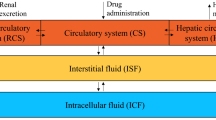Summary
Some of 66 patients with head and neck tumors were treated with high-dose methotrexate monochemotherapy. The use of a prospective mathematical model with pharmacokinetic surveillance proved to be reliable, practical, and useful. By this means chemotherapy could be individualized, with a resultant marked reduction in the frequency and severity of toxicity. The onset of clinical toxic manifestations was significantly correlated with a poor therapeutic response and poor prognosis. The patients were classified in to three groups according to poor, intermediate, and good pharmacokinetic parameters calculated after an intravenous identification dose of methotrexate. These group allocations had a very high prognostic value with regard to toxicity, and especially to the quality of therapeutic response to high-dose methotrexate. They are suggested as useful guidelines in the prescription of high-dose methotrexate chemotherapy.
Similar content being viewed by others
References
Bartels H, Bohmer M (1971) Eine Micromethode zur Krecitinibestimmung. Clin Chim Acta 32:81–85
Bertino JR, Fischer GA (1964) Techniques for study of resistance to folic acid antagonists. Methods in Medical Research 10:297–301
Evans WE, Pratt CB, Taylor RH, Barker LF, Crom WR (1979) Pharmacokinetic monitoring of high-dose methotrexate. Early recognition of high-risk patients. Cancer Chemother Pharmacol 3:161–166
Fischer RA (1924) On a distribution yielding the error functions of several well-known statistics. Proceeding of the Internatinal Mathematical Congress, Toronto, vol 2, pp 805–806
Goh TS, Wong KY, Lampkin B, O'Leary J, Gnarra D (1979) Evaluation of 24-hour infusion of high-dose methotrexate. Pharmacokinetics and toxicity. Cancer Chemother Pharmacol 3:177–180
Lankelma J, Vanderklein E (1980) The role of 7-hydroxymethotrexate during methotrexate anticancer therapy. Cancer Lett 9:133–142
Monjanel S, Rigault JP, Cano JP, Carcassonne Y, Favre R (1979) High-dose methotrexate: preliminary evaluation of a pharmacokinetic approach. Cancer Chemother Pharmacol 3:189–196
Myrs RG, Jacobs SA, Drake JC, Lutz RJ, Chabner BA (1975) Pharmacokinetics of high-dose methotrexate (NSC-740). Cancer Chem Rep 6:19–25
Pinedo HM, Chabner BA (1977) Role of drug concentration, duration of exposure and endogenous metabolites in determining MTX cytotoxicity. Cancer Treat Rep 61:709–715
Schwartz D (1963) Methodes statistiques à l'usage des médecins et des biologistes. Flammarion, pp 67–88
Staquet MJ (1975) Cancer therapy: prognostic factors and criteria of response. Raven Press, New York
Stoller RG, Hands KR, Jacobs SA, Rosenberg SA, Chabner BA (1977) Use of plasma pharmacokinetics to predict and prevent MTX-toxicity. N Engl J Med 297:630–634
Author information
Authors and Affiliations
Rights and permissions
About this article
Cite this article
Favre, R., Monjanel, S., Alfonsi, M. et al. High-dose methotrexate: A clinical and pharmacokinetic evaluation. Cancer Chemother. Pharmacol. 9, 156–160 (1982). https://doi.org/10.1007/BF00257744
Received:
Accepted:
Issue Date:
DOI: https://doi.org/10.1007/BF00257744




